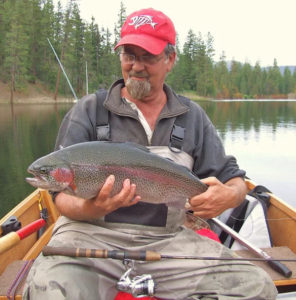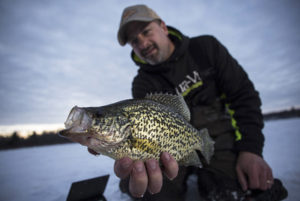New Fisheries Management Plan for Greers Ferry Includes Angler Input
By Randy Zellers
Assistant Chief of Communications
from the Fishing Wire
HEBER SPRINGS — The Arkansas Game and Fish Commission has completed its new fishery management plan for Greers Ferry Lake thanks in part to the input of anglers through recent public meetings and surveys. The plan addresses steps the AGFC will take to improve the fishing experience for all anglers on this popular body of water during the next five years.
According to Matt Schroeder, regional fisheries biologist at the AGFC’s Mayflower Regional Office, there are many aspects of a fishery beyond the control and capability of the AGFC to manipulate. There are, however, some factors the AGFC can address to try to improve the fishery for anglers.
“The lake is owned and operated by the (U.S. Army) Corps of Engineers and its primary purpose is flood control, mandated by The Flood Control Act of 1938,” Schroeder said. “We have talked with them many times about changes to water management for fishery health, but they have to follow the plans handed to them for flood control as their primary purpose. That being said, they work within their mandate as much as they can to help recreation, and Greers is in the top 10 reservoirs in the country for recreational boating.”
Helping Habitat
Because of its primary purpose in flood control, the lake’s water level cannot be manipulated to promote the fishery by flooding shoreline cover during the spawn and lowering it after young-of-the-year fish have grown larger to establish next year’s shoreline vegetation. But that doesn’t mean biologists cannot do anything to improve the lake’s fish habitat.
“Since water level manipulation and seasonal flooding is out of our control, we can work to add as much habitat as we can in the aging reservoir to benefit both fish and anglers,” Schroeder said. “We already have conducted large-scale habitat projects on the lake to give different species year-round options for cover and likely areas for anglers to locate predatory fish such as largemouth bass and crappie. Our new plan will continue with these large-scale habitat projects.”
The new fishery plan also will continue to focus on establishing native aquatic vegetation on Greers Ferry where possible. Aquatic vegetation in a reservoir can add an exceptional amount of spawning and nursery habitat for fish, but it is extremely difficult to establish in reservoirs with highly fluctuating water levels. Efforts to establish aquatic plants in Greers Ferry, Bull Shoals, Greeson, and elsewhere have been largely unsuccessful so far because of massive annual water level changes, but biologists have not given up and are always looking for a better way. AGFC biologists meet regularly with biologists from surrounding states to discuss strategies that have worked elsewhere, but there are few examples of success in highland lakes.
“We will continue to identify suitable native plant species that will benefit the fishery without overtaking it,” Schroeder said. “Once those have been selected, we will conduct plantings of one or more of these species at different locations and depths and evaluate its effect on the fishery before adapting planting strategies for future establishment.”
Fish Food
A tried-and-true program initiated by AGFC biologists at Greers Ferry in the last few years is boosting the forage population of the lake through stockings of threadfin shad. The shad are stocked directly from hatchery trucks and from the lake’s nursery pond located at Mill Creek. Forage species stocked in Greers Ferry before this period consisted primarily of bluegill, which also serve as sport fish. In 2015, fisheries biologists evaluated the forage base and discovered that the lake’s threadfin shad population was depleted. Extremely harsh winters and an abundance of predatory fish likely had taken their toll.
Biologists immediately made plans to stock a crop of bluegill through the nursery and began researching the possibility of stocking threadfin shad the following year. In 2016, 36,500 adult-size and 563,856 fingerling-size threadfin shad were stocked into Greers Ferry. This was followed by an additional 10,000 adults and 1 million fingerlings stocked in 2017 to boost the population. Pre-spawn adult shad were stocked in the nursery pond and allowed to spawn. The shad were even more prolific than expected, and fingerling production was excellent.
“The new plan lays out the need for more focus on forage, calling for more threadfin shad stockings each spring and fall in all parts of the lake,” Schroeder said. “When shad are not available, we will shift to other forage species, such as fathead minnows and bluegill. We also have plans to try some new crayfish stockings once we do enough research to see if we can culture species native to Greers Ferry.”
Schroeder says many anglers present at the focus groups asked for increased stockings of sport fish, such as largemouth and smallmouth bass in addition to the forage, but the lake’s current situation is a lack of food, not predators.
“We would just be adding more mouths to feed into a fishery that already is pretty infertile,” Schroeder said. “And although Florida bass fingerlings have been stocked in the lake in the past, the lake has shown very poor characteristics for those genetics to thrive.”
Halting Hybrids
One management practice that has seen controversy over the last decade is the stocking of hybrid striped bass at Greers Ferry. A manmade cross between the native white bass and the non-native striped bass, the hybrid is a much-sought gamefish in some states and has seen popularity with Arkansas anglers at times. However, during recent creel surveys conducted at the lake, only 4 percent of anglers on Greers were targeting white bass or hybrids. Additionally, a follow-up mail-in survey of willing Greers Ferry creel survey participants conducted by AGFC biologists found that anglers opposed their stocking overall.
Ben Batten, chief of the AGFC’s Fisheries Division, says recent research also suggests hybrids at Greers Ferry could have adverse effects on forage at the rate they currently occur. Of particular interest is the hybrid’s ability to switch forage on Greers Ferry in the absence of open water shad populations.
“When shad populations decline, striped bass will suffer because they don’t readily adapt to different forage and habitat. This helps keep striped bass in check if the shad get scarce,” Batten said. “But recent studies have indicated hybrids may take after their white bass parents and switch to crayfish and other forage that bass, walleye and other gamefish use.”
The last time hybrid striped bass were stocked at Greers Ferry was in 2014. With the lack of angler interest and the concerns over the lake’s forage base, no more hybrids will be stocked for the foreseeable future.
One Foot Across the Black Bass Board
Bass anglers also will note the possibility of a regulation change regarding minimum length limits on largemouth, smallmouth and spotted bass derived from the meetings.
“In 2020, we will propose a straight 12-inch minimum length limit for all three black bass species in Greers Ferry that will be effective in 2021 if it passes Commission approval,” Schroeder said. “There’s currently a 15-inch minimum length limit on largemouth, but recent research has shown no biological need for it to be so high.”
Schroeder explains that minimum length limits are placed on lakes when there is an issue with poor or inconsistent recruitment or when the species sees high mortality rates from harvest. It also requires a good growth rate for fish to move up into harvestable size quickly enough that they don’t overpopulate.
“Recent research suggests that it takes four-and-a-half years for a largemouth to grow beyond the 15-inch minimum length limit, and that the annual rate of mortality from natural and catch-and-release angling combined only reaches 30 percent of the population in a given year,” Schroeder said. “And our game fish species are currently at or above the carrying capacity that the lake can support, so we need to increase harvest of some fish to enable faster growth rates.”
Schroeder says adding the minimum length limit on spotted bass was part of the AGFC’s current goal of keeping regulations simple. A standard 12-inch length limit will be easier for anglers to remember and won’t penalize any tournament anglers looking to bring fish to the weigh-in.
“No matter which species, if it’s a black bass it will have to be 12 inches long to keep if the regulation passes next year,” Schroeder said. “Anglers won’t have to worry about trying to identify a spotted bass from a largemouth.”
Helping Hands
The good turnout at both Greers Ferry public meetings as well as at the recent town hall meeting with Commissioners gives biologists and administrators hope a new resource can be used more effectively in the future — the anglers themselves. Many focus group attendees said they would be willing to volunteer their time to participate in future habitat projects and other initiatives to help the lake’s fishery. Schroeder says habitat projects are an ideal way anglers can contribute to be a part of the solution, and the amount of habitat that can be added can be greatly enhanced.
“Moving forward, we will try to reach out through media outlets and create a volunteer distribution list for help,” Schroeder said. “We’re anglers too, that’s why we wanted to be fisheries biologists in the first place. I think there are a lot of areas where we can all work together to help the Greers Ferry fishery.”
The complete Greers Ferry Fishery Management Plan and management plans for other lakes in the state are available at www.agfc.com/fishmanagement.

